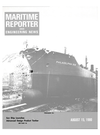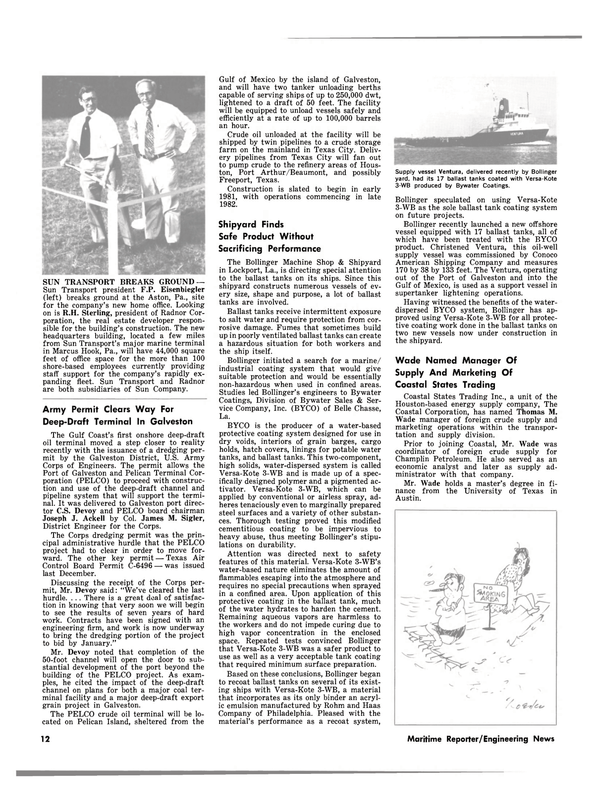
Advanced Design Product Tanker Launched At Sun Ship
The Philadelphia Sun, second of a new class of fuel-efficient, dieselp o w e r e d coastal tankers under construction for Sun Transport, was launched recently at the Chester, Pa., yard of Sun Ship.
A cheering crowd of more than 8,000 guests, employees and their families looked on as Mrs. Pat Green, wife of Philadelphia Mayor William Green, smashed the traditional bottle of champagne against the bow of the new product carrier.
The launching ceremonies included remarks from William G.
Kay Jr., executive vice president of the Sun Company; Samuel B.
Nemirow, Assistant Secretary of Commerce for Maritime Affairs; and Joseph J. Kleschick, vice president of Sun Ship.
The launching address was given by Sun Ship president Robert H. Campbell, and included a special tribute to the 4,000 shipyard workers whom he described as "shipbuilders in the Philadelphia tradition . . . the finest tradition." Sun Transport's design for the Philadelphia Sun and sister ship New York Sun, (See MARITIME REPORTER issue of October 15, 1979, page 22.), which is now being outfitted prior to sea trials, anticipated the regulatory changes that have evolved since construction of these vessels began. The new ships incorporate many of the environmental and safety features that succeeding legislation was to make mandatory for tanker designs in the future.
Outstanding features of the Philadelphia Sun include a high level of automation, permitting control of engine speed and direction from the bridge; air conditioned crew quarters; and an elevator connecting the four superstructure decks with the engine room. Six pumps will discharge the tanker's 247,000-barrel cargo in 15 hours.
The 34,400-dwt ships have an overall length of 612 feet, beam of 90 feet, depth of 49.5 feet, and draft of 36.75 feet. Propulsion is provided by a single 14,200-bhp Mitsubishi,/Sulzer type RND-M slow-speed diesel engine, providing a service speed of 15.5 knots.
Each vessel is capable of carrying six different types of refined petroleum products at once, including gasoline, k e r o s e n e , j et fuel, heating oil, and naphtha.
The P h i l a d e l p h i a Sun is equipped with a wide array of modern navigational aids, including a collision-avoidance radar system, a satellite navigation system to enable the ship's crew to pinpoint its exact position at any given time, and a weather facsimile system that provides up-tothe- minute weather reports to the ship's officers.
A segregated ballast system has a total saltwater capacity of 12,000 long tons. With this system, several of the vessel's tanks are used only for ballast. This means that when the tanker's ballast water is pumped out during the deballasting cycle during savcargo loading, only clean salt water will be released.
In contrast to general practice in older tankers, ballast is not introduced into tanks that also carry the various petroleum cargoes.
Should conditions at sea necessitate additional ballast water being pumped into any of the ship's cargo tanks, an oil-water separator removes petroleum residue from the ballast water before it is pumped overboard.
A sewage storage and treatment plant has been installed to insure that raw sewage cannot be discharged at sea.
The Philadelphia Sun will be assigned to various U.S. intracoastal trade routes. She is the first vessel named for the City of Philadelphia in the history of the Sun Company fleet.
Read Advanced Design Product Tanker Launched At Sun Ship in Pdf, Flash or Html5 edition of August 15, 1980 Maritime Reporter
Other stories from August 15, 1980 issue
Content
- Red Fox Will Build Jackup Barges At Newly Acquired Yard page: 6
- James Steadman Joins Halter Marine As VP For Special Assignments page: 6
- Simrad Introduces New Trawl Echo Recorder- Literature Available page: 8
- Robert Strasser Joins MacGregor, U.S.A. As Technical Director page: 8
- Bird-Johnson Appoints Richard E. McGinnis A Trustee And Director page: 9
- Halifax Shipyards Gets C$27-Million Order For Three Stern Trawlers page: 9
- Advanced Design Product Tanker Launched At Sun Ship page: 10
- Coast Guard Approves Butterworth Systems Oil/Water Separators page: 10
- New Bulletin Describes Improved Diesel Cylinder Liner Plating Process page: 10
- Army Permit Clears W a y For Deep-Draft Terminal In Galveston page: 12
- Shipyard Finds Safe Product Without Sacrificing Performance page: 12
- Zapata To Acquire Offshore Services Ltd. From Trafalgar House page: 13
- ITO Announces Six Promotions—R.J. Nolan Named Executive VP page: 15
- Technical Report On Sea-Shed Conversions Available From MarAd page: 15
- Ogden Equips Fleet With Satellite Navigators page: 15
- Nav-Com Relocates To Larger Quarters page: 16
- Maumenee, Roy And Snellman Promoted At Alabama Dry Dock page: 18
- Appledore And DnV To Assist In Operation Of Okpo Shipyard page: 18
- Michigan Wheel Announces Formation Of Propulsion Systems Group page: 18
- Marland Has New MSD For Smaller Vessels- Literature Available page: 20
- Waller & Associates To Provide Engineering Services For Ingram page: 20
- San Francisco To Build New Fireboat Designed By Morris Guralnick page: 21
- Halter Delivered 30 Big Commercial Vessels In First Half Of 1980 page: 22
- James Rhodes Appointed Communications Director For Navidyne Corp. page: 22
- B&W Yard Given Danish Gov't Guarantee For Bulk Carrier Construction page: 24
- Transoceanic Designated As U.S. Forwarder For NACAP Project page: 26
- Griff Lee, McDermott VP, Elected To National Academy Of Engineering page: 28
- James J . Murphy Named VP-Marketing For General Dynamics' Marine Group page: 28
- Lucander And Dowhos Form Design Association page: 29
- American Manufacturing Announces Three Sales Appointments page: 32
- Gene Ossi Establishes New Automation Firm- Brochure Available page: 32
- Trikora Lloyd Buys Three Ships At Total Cost Of $45 Million page: 32
- Michael Warren Joins Farboil As National Accounts Manager page: 32
- Dravo SteelShip Delivers Towboat To Pleasants Power Station page: 34
- Dillingham Forms New Subsidiary To Operate In Gulf Coast Area page: 34
- Hydranautics Awarded BP Magnus Field Platform Contract page: 34
- Collins Elected President And General Manager Of Houston Systems Mfg. page: 34
- Multipurpose Cargo Vessel 'Sarita' Delivered By Hitachi page: 34
- David Jackson Appointed Vice President For Sun State Marine page: 37
- New MMC Gauging System Meets IMCO Guidelines- Literature Available page: 37
- Farrell Lines Announces Three New Appointments— Breslin To VP-Controller page: 38
- Gaston Joins Bulkfleet Marine As Manager Of Engineering Services page: 38
- Three New Managers Appointed By CDI Marine Company page: 39
- Hayward Marine Products New Name For Former Mechanical Marine page: 39
- Miles Heads Barber Blue Sea Activities In North America page: 40
- First Vessel Extruded From Covered Hall At Cammell Laird page: 40
- McDermott Division Gets Two Contracts For Irish Sea Gas Projects page: 41
- New Company Plans To Build Two Bulk/Container Ships At Cost Of $156 Million page: 42
- Cameron Refits Drill Rig 'Western Pacesetter II' In Record-Breaking Five Days page: 42
- Carriere Named Manager Of Lykes M&R Division In San Francisco page: 44
- Evergreen Handt Merged Into Evergreen Marine— Hansen Named President page: 44


